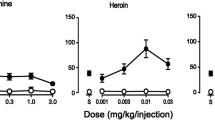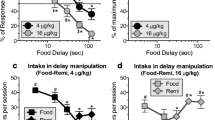Abstract
Rationale
Opioid abuse remains a serious public health problem. The pseudoirreversible mu opioid receptor antagonist methocinnamox (MCAM) might be useful for treating opioid abuse and overdose. Because endogenous opioid systems can modulate cognition and decision-making, it is important to evaluate whether long-term blockade of mu opioid receptors by MCAM adversely impacts complex operant behavior involving memory.
Objective
This study tested the effects of MCAM in rhesus monkeys responding under a delayed matching-to-sample task, with correct responses reinforced by sucrose pellets. Because MCAM did not alter performance, antagonism of the rate-decreasing effects of morphine was used to confirm that an effective dose of MCAM was administered. Moreover, the muscarinic receptor antagonist scopolamine and the N-methyl-D-aspartate antagonist phencyclidine were studied as positive controls to demonstrate sensitivity of this procedure to memory disruption.
Results
Neither MCAM (0.32 mg/kg) nor morphine (1–5.6 mg/kg) impaired delayed matching-to-sample accuracy. Morphine dose-dependently decreased the number of trials completed before MCAM administration, and a single injection of MCAM blocked the behavioral suppressant effects of morphine for at least 7 days. Scopolamine (0.01–0.056 mg/kg) and phencyclidine (0.1–0.56 mg/kg) dose-dependently decreased delayed matching-to-sample accuracy and the number of trials completed.
Conclusions
MCAM did not impair memory (as measured by accuracy in a delayed matching-to-sample task) and did not decrease responding for or consumption of sucrose pellets. This dose of MCAM attenuates self-administration of opioids and reverses as well as prevents opioid-induced respiratory depression. These results provide further support for a favorable adverse effect profile for MCAM.




Similar content being viewed by others
References
Bain JN, Prendergast MA, Terry AV, Arneric SP, Smith MA, Buccafusco JJ (2003) Enhanced attention in rhesus monkeys as a common factor for the cognitive effects of drugs with abuse potential. Psychopharmacology 169:150–160
Blough DS (1959) Delayed matching in the pigeon. J Exp Anal Behav 2:151–160
Broadbear JH, Sumpter TL, Burke TF, Husbands SM, Lewis JW, Woods JH, Traynor JR (2000) Methocinnamox is a potent, long-lasting, and selective antagonist of morphine-mediated antinoniception in the mouse: comparison with clocinnamox, β-funaltrexamine, and β-chlornaltrexamine. J Pharmacol Exp Ther 294:933–940
Carpenter M, Berry H, Pelletier AL (2019) Clinically relevant drug-drug interactions in primary care. Am Fam Physician 99:558–564
Chamberlain SR, Mogg K, Bradley BP, Koch A, Dodds CM, Tao WX, Maltby K, Sarai B, Napolitano A, Richards DB, Bullmore ET, Nathan PJ (2012) Effects of mu opioid receptor antagonism on cognition in obese binge-eating individuals. Psychopharmacology 224:501–509
Cohen RM, Cohen RM, Pickar D, Weingartner H, Murphy DL (1983a) High-dose naloxone infusions in normal: dose-dependent behavioral, hormonal, and physiological responses. Arch Gen Psychiatry 40:613–619
Cohen RM, Cohen MR, Weingartner H, Pickar D, Murphy DL (1983b) High-dose naloxone affects task performance in normal subjects. Psychiatry Res 8:127–136
Compton WM, Jones CM (2019) Epidemiology of the U.S. opioid crisis: the importance of the vector. Ann NY Acad Sci 1451(1):130–143. https://doi.org/10.1111/nyas.14209 [e-pub ahead of print]
Cooper SJ, Moores WR, Jackson A, Barber DJ (1985) Effects of tifuadom on food consumption compared with chlordiazepoxide and kappa agonists in the rat. Neuropharmacology 24:877–883
Dahan A, Aarts L, Smith TW (2010) Incidence, reversal, and prevention of opioid-induced respiratory depression. Anesthesiology 112:226–238
Danysz W, Wroblewski JT, Costa E (1988) Learning impairment in rats by N-methyl-D-aspartate receptor antagonists. Neuropharmacology 27:653–656
Flood JF, Cherkin A, Morley JE (1987) Antagonism of endogenous opioids modulates memory processing. Brain Res 422:218–234
Freeman FM, Young IG (2000) Identification of the opioid receptors involved in passive-avoidance learning in the day-old chick during the second wave of neuronal activity. Brain Res 864:230–239
Gerak LR, Maguire DR, Woods JH, Husbands SM, Disney A, France CP (2019a) Reversal and prevention of the respiratory-depressant effects of heroin by the novel mu-opioid receptor antagonist methocinnamox in rhesus monkeys. J Pharmacol Exp Ther 368:229–236
Gerak LR, Minervini V, Latham E, Ghodrati S, Lillis KV, Wooden J, Disney A, Husbands SM, France CP (2019b) Methocinnamox (MCAM) produces long-lasting antagonism of the behavioral effects of μ opioid receptor agonists but not prolonged precipitated withdrawal in rats. J Pharmacol Exp Ther 371(2):507–516. https://doi.org/10.1124/jpet.119.260331 [e-pub ahead of print]
Hutsell Blake A, Banks ML (2015) Effects of environmental and pharmacological manipulations on a novel delayed nonmatching-to-sample “working memory” procedure in unrestrained rhesus monkeys. J Neurosci Methods 251:62–71
Jones JD, Mogali S, Comer SD (2012) Polydrug abuse: a review of opioid and benzodiazepine combination use. Drug Alcohol Dependence 125:8–18
Kim HS, McCarthy DM, Courtney DM, Lank PM, Lambert BL (2017) Benzodiazepine-opioid co-prescribing in a national probability sample of ED encounters. Am J Emerg Med 35:458–464
Lenard NR, Zheng H, Bethoud HR (2010) Chronic suppression of mu-opioid receptor signaling in the nucleus accumbens attenuates development of diet-induced obesity in rat. Int J Obes 34:1001–1010
Maguire DR, Gerak LR, Woods JH, Husbands SM, Disney A, France CP (2019) Long-lasting effects of methocinnamox on opioid self-administration in rhesus monkeys. J Pharmacol Exp Ther 368:88–99
Mathews MJ, Mead RN, Galizio M (2018) Effects of N-methyl-D-aspartate (NMDA) antagonists ketamine, methoxetamine, and phencyclidine on the odor span test of working memory in rats. Exp Clin Psychopharmacol 26:6–17
McMillan DE (1981) Effects of chemicals on delayed matching behavior in pigeons I: acute effects of drugs. Neurotoxicology 2:485–498
Minervini V, France CP (2018) Effects of morphine/CP55940 mixtures on an impulsive choice task in rhesus monkeys. Behavioural Pharmacology 29:6–70
Nathan PJ, Bush MA, Tao WX, Koch A, Davies KM, Maltby K, O’Neil BV, Napolitano A, Skeggs AL, Brooke AC, Richards DB, Williams PM, Bullmore ET (2012) Multiple-dose safety, pharmacokinetics, and pharmacodynamics of the mu-opioid receptor inverse agonist GSK1521498. J Clin Pharmacol 52:1456–1467
Papaleo F, Kieffer BL, Tabarin A, Contarino A (2007) Decreased motivation to eat in mu-opioid receptor-deficient mice. Eur J Neurosci 25:3398–3405
Peckham EM, Barkley LM, Divin MF, Cicero TJ, Traynor JR (2005) Comparison of the antinociceptive effect of acute morphine in female and male Sprague-Dawley rats using the long-lasting mu-antagonist methocinnamox. Brain Res 1058:137–147
Pergolizzi JV, Rosenblatt M, LeQuang JA (2019) Three years down the road: the aftermath of the CDC guideline for prescribing opioids for chronic pain. Adv Ther 36:1235–1240
Qi JA, Heyman JS, Sheldon RJ, Koslo RJ, Porreca F (1990) Mu antagonist and kappa agonist properties of beta-funaltrexamine (beta-FNA) in vivo: long-lasting spinal analgesia in mice. J Pharmacol Exp Ther 252:1006–1011
Steinmiller CL, Young AM (2008) Pharmacological selectivity of CTAP in a warm water tail-withdrawal antinociception assay in rats. Psychopharmacology 195:497–507
Strand MA, Eukel H (2019) A primary prevention approach to the opioid epidemic. Am J Public Health 109:861–863
Thompson DM, Mastropaolo J, Winsauer PJ, Moerschbaecher JM (1986) Repeated acquisition and delayed performance as a baseline to assess drug effects on retention in monkeys. Pharmacol Biochem Behav 25:201–207
Van Steenbergen H, Eikemo M, Leknes S (2019) The role of the opioid system in decision making and cognitive control: a review. Cogn Affect Behav Neurosci 19:435–458.
White GK (1985) Characteristics of forgetting functions in delayed matching to sample. J Exp Anal Behav 44:15–34
Yamamoto S, Nishiyama S, Kawamata M, Ohba H, Wakuda T, Takei N, Tsukada H, Domino EF (2011) Muscarinic receptor occupancy and cognitive impairment: a PET study with [11C](+)3-MPB and scopolamine in conscious monkeys. Neuropsychopharmacology 36:1455–1465
Yeomans MR, Gray RW (1997) Effects of naltrexone on food intake and changes in subjective appetite during eating: evidence for opioid involvement in the appetizer effect. Physiol Behav 62:15–21
Young AM, Woods JH (1982) Limitations on the antagonistic actions of opioid antagonists. Fed Proc 41:2333–2338
Acknowledgments
The authors thank Lisa Gerak and David Maguire for the helpful comments on the manuscript.
Funding
This work was supported by the National Institutes of Health (NIH) National Institute on Drug Abuse (Grants R01DA005018 (to CPF), R01DA048417 (to CPF), and R01DA07315 (to SMH)) and the Welch Foundation (Grant AQ-0039 (to CPF)). The content expressed here is solely the responsibly of the authors and does not necessarily represent the views of the NIH.
Author information
Authors and Affiliations
Corresponding author
Ethics declarations
Conflict of interest
CPF is a coholder of a US provisional patent for MCAM.
Additional information
Publisher’s note
Springer Nature remains neutral with regard to jurisdictional claims in published maps and institutional affiliations.
Rights and permissions
About this article
Cite this article
Minervini, V., Disney, A., Husbands, S.M. et al. Methocinnamox (MCAM) antagonizes the behavioral suppressant effects of morphine without impairing delayed matching-to-sample accuracy in rhesus monkeys. Psychopharmacology 237, 3057–3065 (2020). https://doi.org/10.1007/s00213-020-05592-y
Received:
Accepted:
Published:
Issue Date:
DOI: https://doi.org/10.1007/s00213-020-05592-y




